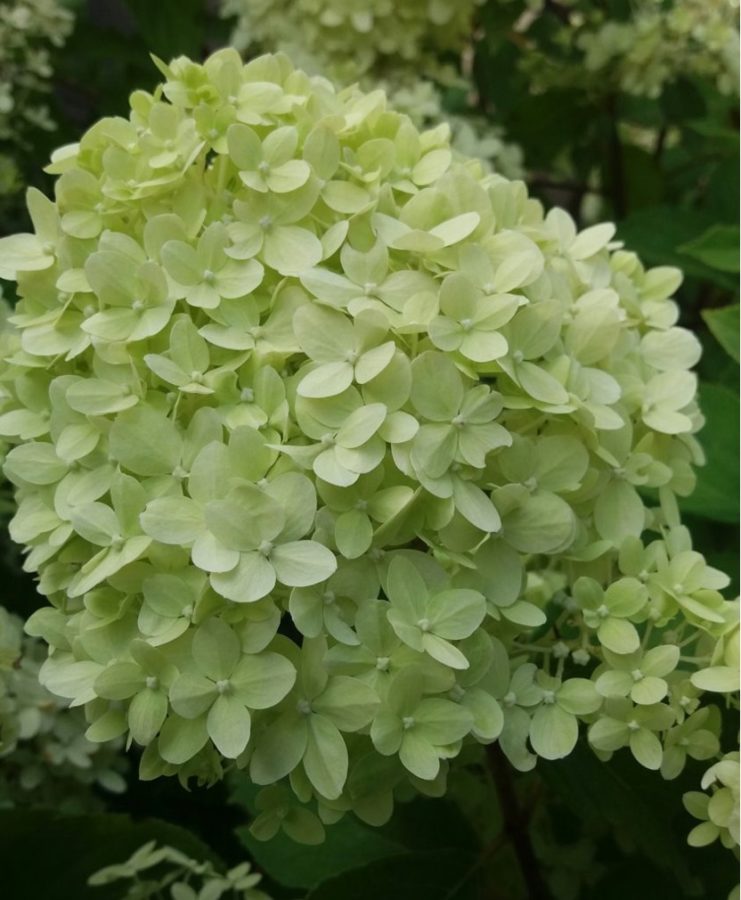Hydrangeas are useful for a range of garden sites. They are excellent as specimen plants or in group planting, in a shrub border, or in containers. Use the climbers to clothe a shaded wall or fence. The flowerheads may be dried for use in flower arrangements.
They can be fully hardy to frost hardy depending on the variety.
Grow Hydrangeas in moist but well-drained, moderately fertile, humus-rich soil in full sun or partial shade. Provide shelter from cold, drying winds. Some Hydrangeas will become chlorotic in shallow chalk soil.
Flower colour in the macrophylla group are affected by the relative availability of aluminium ions in the soil. Acid soils with a pH of less than 5.5 produce blue flowers; soils with a greater pH than this produce pink flowers. In more or less neutral soils, flower colour can be influenced by the addition of blueing compound if you want to keep blue flowering types ‘blue’. White flowers are not affected by pH levels in the soil.
Hortensia hydrangeas (also known as mopheads) are compact bushy deciduous shrubs with broadly ovate leaves and rounded flower clusters composed almost entirely of showy sterile flowers.
Try:-
‘Madame Emile Mouillere’ is a small deciduous shrub height up to 1.8m, with large oval leaves and Hortensia-type, rounded heads of white sterile florets, the sepals are serrated and sometimes tinged pink in full sun.
‘Masja’ is a bushy more compact variety with deep green foliage and large red flowerheads. Height up to 90cm, makes a good informal hedge.
‘Little Hortensia’ is a new form of the most compact hydrangeas, it’s perfect for patios and front border positions. The glowing flowers in pink, blue, white or purple appear for months on end and can be cut for fresh or dried flower arrangements. Height and width 60cm x 60cm.
Try the paniculata range of hydrangeas, they have frothy conical flower heads and upright growth; flowering from late summer to early Autumn. Give them a go they are spectacular!!
Hydrangea paniculata is a vigorous, spreading to upright, deciduous shrub with large conical panicles, 7-20cm (3-8”) tall of creamy white fertile flowers and large, pinkish white sterile flowers borne in late summer, early autumn. (To obtain larger flowerheads on cultivars, cut back previous season’s shoots to within a few buds of the woody framework in spring.) Height 3-7m (10-22’), spread 2.5m (8’), origin Russia, China and Japan; fully hardy.
‘Lime Rickey’ is a compact deciduous shrub producing large, rounded lime green flowers on strong sturdy stems in the summer usually from May to September. Eventual height from 0.9 to 1.2m (3’-4’)
‘Phantom’ has enormous white flower panicles, which emerge pale green in early summer and fade to white as they mature. For best results, prune back hard to around 30cm above ground level each year, and mulch with a thick layer of well-rotted organic matter. Height 1-1.5m (3’–5’).
‘Diamante Rouge’ – when the flowers first appear the petal-like sepals are white but they soon start to change colour , first to pink and then a deeper shade of rich raspberry red. Height 1.2m (4’)
‘Limelight’ has very dense flowerheads, large greenish-white panicles that turn pink as the season progresses, height 1.65m (5.5’).

Hydrangea-paniculata-Limelight
‘Magical Candle’ is a delightful hydrangea with delicate panicles of greeny cream flowers which change to white with age, it is upright and does not flop. Prefers a rich soil in a sunny or semi-shaded site. Height and spread 4-5’
‘Grandiflora’ has large flowerheads, 20-30cm (8”-12”) tall, of mainly sterile white blooms that turn pinkish with age.

Hydrangea-paniculata-Grandiflora
‘Vanille Fraise’ has fluffy, loose pyramid-shaped flower panicles, creamy white turning shades of pink as they age, flowers July-October.

Hydrangea-paniculata-Vanilla-Fraise
